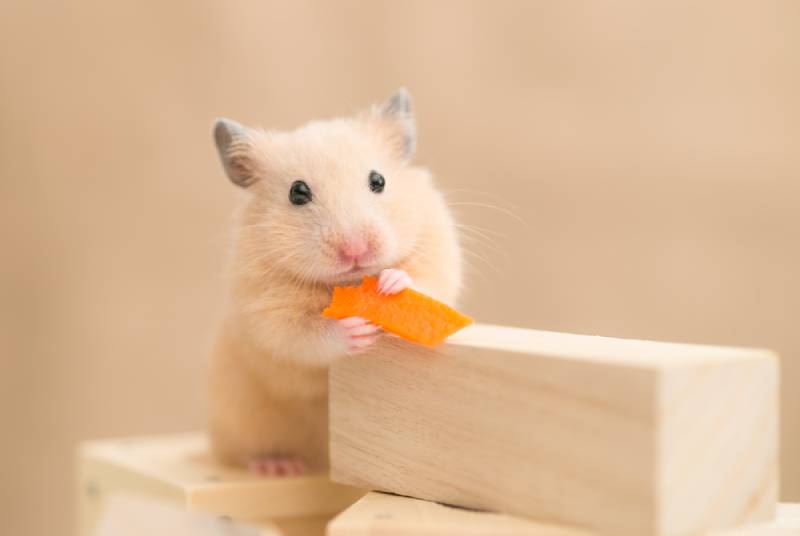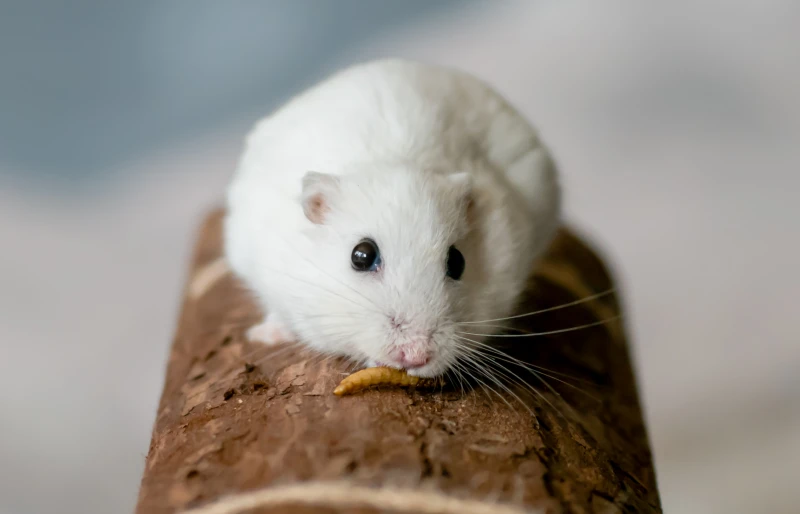Hamsters vs. Gerbils: The Main Differences (Vet-Verified Info With Pictures)
By Cheryl Regan
Updated on
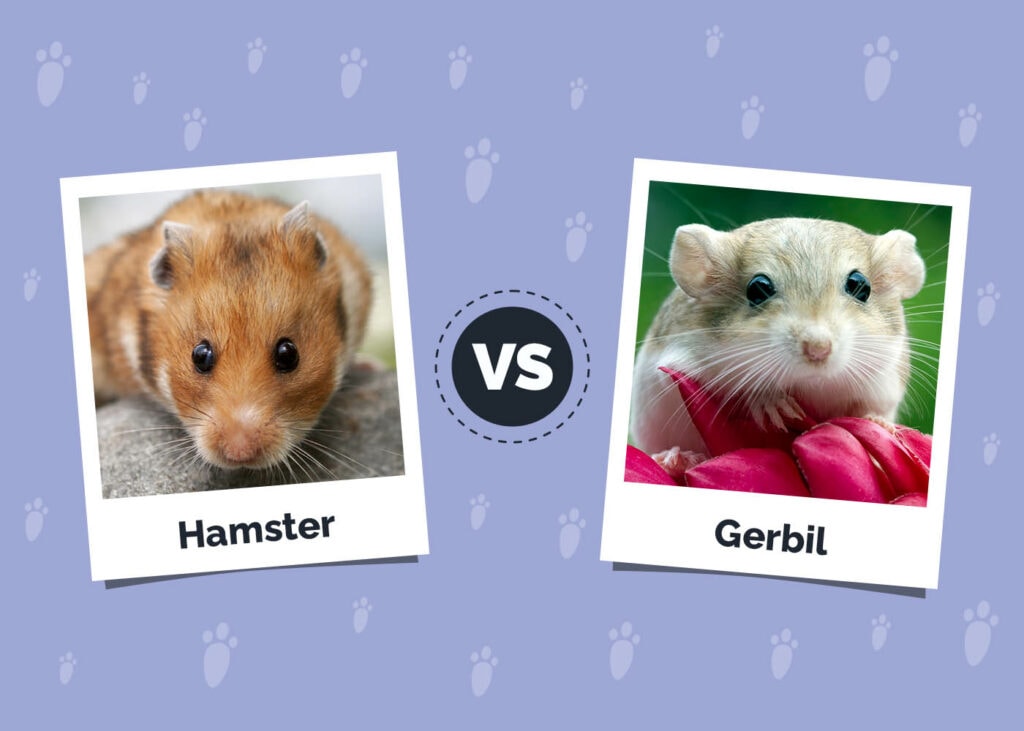
Click to Skip Ahead
Undoubtedly two of the most common animals bought as first-time pets for children, both hamsters and gerbils are adorable, excitable, and entertaining. Despite their equal cuteness, the differences between hamsters and gerbils can be quite significant.
Hamsters are slightly larger and fuller than gerbils and tend to be solitary animals, whereas gerbils are more social, preferring to be in pairs or small groups. Gerbils also have an exceptionally long tail that is often nearly as long as the rest of their body!
In this article, we’ll tell you everything you need to know about these friendly rodents, including their sleeping habits, characteristics, personalities, and care needs, so you can decide which is best for you.
Visual Differences
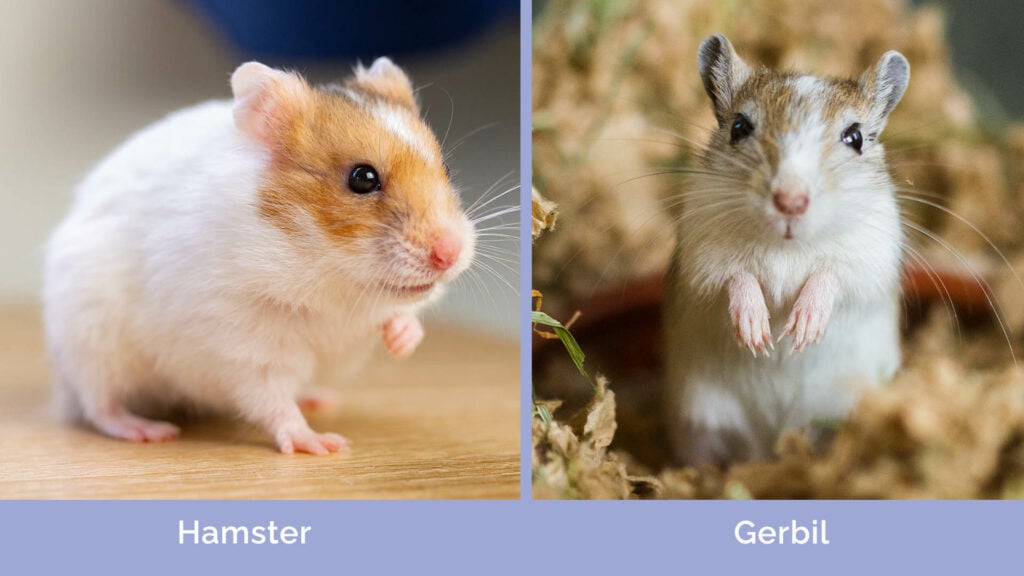
At a Glance
- Average length (adult): 2–7 inches (depending on species)
- Average weight (adult): 0.5–5 ounces (depending on the species)
- Lifespan: 1–4 years
- Grooming needs: Often low
- Family-friendly: Usually
- Trainability: Limited potential for training
- Average length (adult): 8–10 inches (including tail)
- Average weight (adult): 2–4 ounces
- Lifespan: 3–4 years on average, record at over 6 years
- Grooming needs: Low
- Family-friendly: Yes
- Trainability: Limited potential for training
Hamster Overview
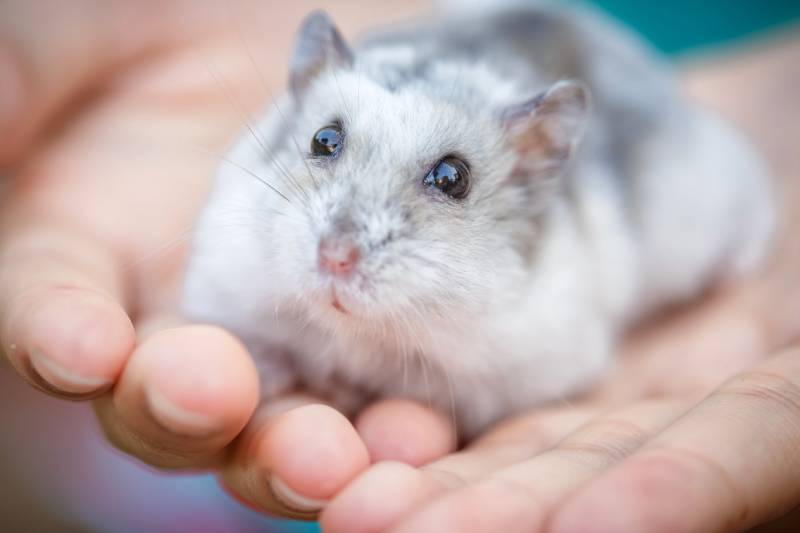
These nocturnal little rodents are known for their fluffy, round appearance, adorable cheek pouches, and playful nature. Depending on which species of hamster you choose, they can be as small as 2 inches in length (Roborovski dwarf hamster) or as large as 7 inches in length (Syrian hamster). They come in various coat colors, ranging from gold and tan to white, gray, black, or brown.
Personality
Hamsters are prey animals, so they tend to be shy and skittish when you first bring them home. With patience and training, however, most hamsters will get used to being handled. However, they need to be socialized at a young age to ensure success with being hand-tamed.
It’s worth noting that hamsters are nocturnal creatures. To avoid predators, these tiny rodents sleep during the day and wake up at night. When they are awake, however, these pets are energetic and can be very entertaining.
The last thing you should know about pet hamsters is that they are not naturally social animals! They are solitary creatures, preferring to be alone. Most hamsters will prefer to have the cage to themselves, and while Dwarf hamsters may get used to sharing a cage provided they are introduced at a young age, are close in age (ideally littermates), and preferably the same sex, Syrian and Chinese hamsters, in particular, can get aggressive if they are housed in pairs or groups.
Training
Some people have made claims that after bonding with your hamster, you can train them to stand, jump, and even roll over! However, this is debated from a scientific perspective, as it seems the hamster is simply moving in an intended way once they get accustomed to a specific smell (such as that of their owner’s hand or a treat). The ability of training methods to be replicated in hamster training is very limited, suggesting that what owners perceive as successful training is merely conditioning for a specific hamster.
Nonetheless, almost all hamsters that have been socialized at a young age have the potential to respond to a specific smell, which you can associate with a specific sound (such as you calling to them) to perform a specific task.
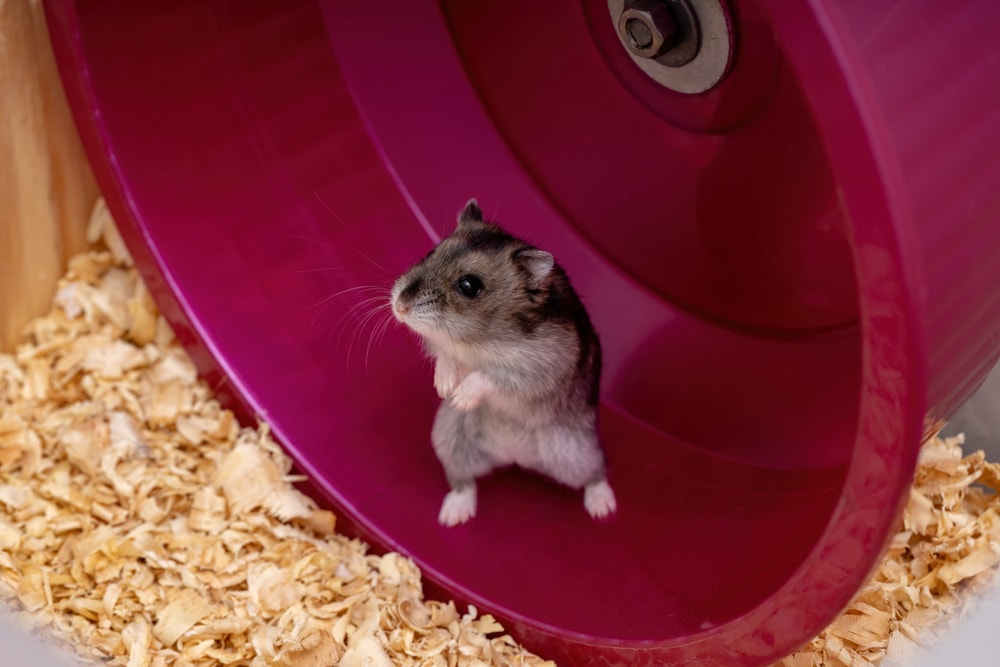
Health & Care
Hamsters are relatively low-maintenance pets when compared to dogs and cats, but you will still need to ensure that you provide them with a clean, safe, and appropriate cage. You’ll need to use dust-free bedding such as paper-based bedding or aspen wood shavings.
Your pet hamster’s bedding will need changing one to two times per week, though bear in mind that this depends on the size of your hamster cage and how many hamsters you have. With smaller cages, you may need to change the bedding more often.
In addition to changing their bedding, you’ll need to wash and dry your hamster’s cage once or twice per week or every other week.
A hamster’s home isn’t just about bedding. Pet hamsters have a lot of energy, which they need to burn off—usually at night. Hamster wheels are perfect for this, but you should also consider adding tunnels and toys, such as ladders and treat balls.
Suitable For:
Hamsters are perfect first-time pets for children aged 8 and older. Caring for a hamster can teach a child responsibility, but they will still need supervision when handling their pet. Bear in mind that hamsters will sleep for the majority of the day, so small children may not get to see them being very active.
Gerbil Overview
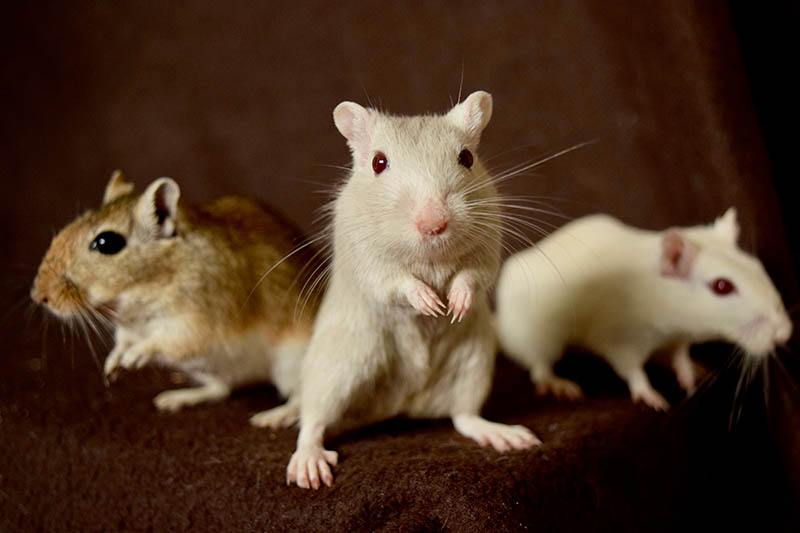
Gerbils (Meriones unguiculatus) are notoriously playful. These little rodents are highly social and thrive when grouped with other gerbils. They’re also outwardly affectionate towards family or group members they are bonded with, often playing together, chasing each other around, grooming one another, and cuddling.
Unlike hamsters, gerbils are diurnal creatures, which means they’re active during the day, though you should note that they do have periods of rest during the day, and equally, most gerbils have periods of activity during the night.
Personality
Thanks to their inquisitive and affectionate natures, gerbils quickly burrow into their owners’ hearts. Gerbils are highly social animals and will be much happier in a pair or group. In fact, gerbils should never be kept alone, as they can quickly become stressed from loneliness!
As social animals, gerbils rely on communicating using non-verbal signals that you can learn to watch out for. For instance, gerbils turn away and thump their hind legs to signal fear.
Training
As intelligent, food-driven pets, gerbils are perfect for training. Gerbils may be shy when you first bring them home, but once you’ve bonded, you can start teaching them tricks, such as coming to you when called, standing on their hind legs, spinning, and even jumping into your hand. Again, it is important to note that this isn’t necessarily a replicable method and whether or not they can be trained in a true sense remains up for debate in the scientific community.
The first step in training your gerbils is to get them to trust you. Gain your pet’s trust by holding them daily until they feel comfortable with you. When training, pair the trick or behavior you want your gerbil to learn with a clear auditory command and use a tasty treat for positive reinforcement when they get it right.
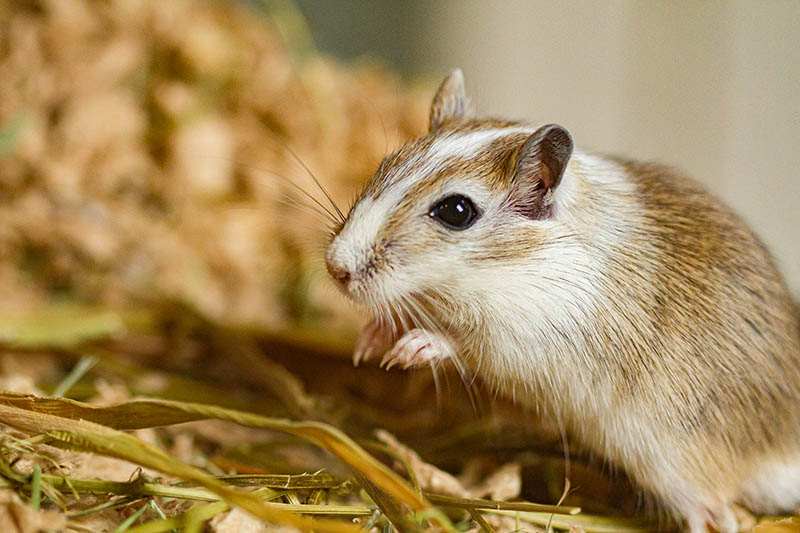
Health & Care
Like hamsters, gerbils are relatively low-maintenance pets. You’ll need to find an appropriately sized gerbilarium or tank with lots of space, lined with unscented paper-based bedding, allowing them to dig, burrow, hide, and run around. In addition to food bowls and water bottles, gerbils need a pot of sand that they can use as a dust bath to clean themselves.
As is the case with all pet rodents, you’ll need to change the toilet area of their bedding once a week. Depending on the number of gerbils you have, you may need to change the bedding more often. The good news is that, like hamsters, gerbils tend to use the same area to go potty.
Be sure to provide your gerbils with toys, including hiding spots and little wooden houses, tubes, tunnels, wheels, and climbing toys.
Suitable For:
Gerbils make great first-time pets for children, as they are awake during the day, are quite social, and are unlikely to bite. They’re suitable for families looking to get more than one pet, as you’ll need to get at least a pair of gerbils, if not a group! Gerbils have a 3–4-year lifespan, and with more than one pet, you should be prepared to care for them for a while! Though they should be housed in groups, it’s important to note that the dominant females will continuously mate with the dominant male, and therefore, you should have a plan for what to do with their babies as they reproduce. Gerbils are extremely prolific.
Which Pet Is Right for You?
When deciding between gerbils and hamsters, there are a few factors to consider. If you’re looking to get just one pet, then a solitary hamster will suit you better. On the other hand, if you’re looking for a pair or a group of pets, it’s best to go for gerbils, who love being social. However, as mentioned above, their numbers can get out of hand very quickly!
Gerbils tend to be awake more during the day and will likely get used to the activity routine of their household, whereas hamsters will spend most of the day sleeping and then come out during the night. For small children who are likely to sleep before a hamster wakes up, gerbils may be more interesting.
But it’s not just kids who can benefit from a hamster or gerbil companion. Both options can make entertaining, mostly hands-off pets for adults and couples. As long as you can provide a safe environment for your pet, keep their cage and bedding clean, and give them the attention they need, both animals are fantastic options.
Featured Image Credit: (L) Anastasia Solovykh, Shutterstock | (R) Kurit afshen, Shutterstock


